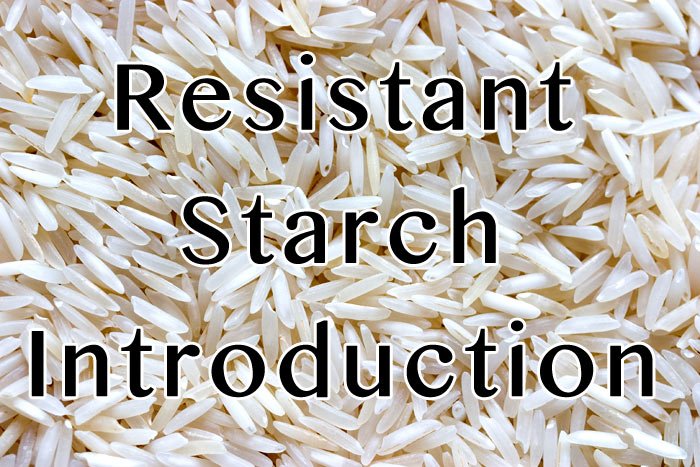Last Updated on December 28, 2016 by Marc Seward
What is resistant starch?
The bulk of the carbohydrates that we eat are starches which are long glucose chains typically found in foods like grains and potatoes. While some of the starch that we consume gets digested, some of it passes through the digestive system unchanged.
These starches do not get digested hence the term ‘resistant starch’. These resistant types of starch function in a similar way to soluble fiber and there are plenty of studies which demonstrate that it has numerous, powerful benefits to our health. Health benefits range from reduced blood sugar levels to weight control and digestive health.
While people often refer to resistant starch as an individual entity, there are actually four different types of resistant starch which act in different ways.
Type 1: This type of starch which is found in legumes and grains resists digestion by being bound within the fiber cell walls.
Type 2: This type is present in certain starchy food including unripe bananas and raw potatoes.
Type 3: This type of resistant starch is formed when certain starchy foods like rice and potatoes are cooked before being cooled. The cooling process transforms some of the previously digestible starches to resistant starches by a process known as retrogradation.
Type 4: this last type of resistant starch is man-made through chemical processes. It is basically a synthetic form of resistant starch that most experts do not recommend.
What are the benefits?
Your gut is home to millions of bacteria some of which is performs vital health functions. Maintaining a balance is vital to our health and resistant starch can selectively stimulate friendly bacteria in the gut.
Through the process of fermentation, this good bacteria feeds on resistant starch which produces important short chain fatty acid such as acetate, propionate and butyrate. Resistant starch increases the production of these fatty acids and has a beneficial effect on digestive and overall health.
Butyrate is especially significant as it plays numerous roles in digestive and metabolic health; it reduces inflammation and improves stress resistance.
Blood sugar levels and insulin sensitivity
Chronically elevated levels of blood glucose and insulin resistance are linked to a whole host of diseases such as metabolic syndrome. A number of studies have demonstrated that resistant starch can improve both blood glucose levels and insulin sensitivity.
A study published in Diabetes care in 2006 found that resistant starch improved glucose metabolism in both overweight women and those of a normal weight. (1)
Another study published in 2010 found that consuming 40 grams a day of resistant starches improved insulin sensitivity in those with metabolic syndrome. (2)
In yet another study, it was demonstrated that the daily consumption of between 15 and 30 grams of resistant starch had a beneficial effect on insulin sensitivity in obese and overweight males. This improvement was equivalent to that expected from a 10% loss of weight. (3)
Studies have also demonstrated that resistant starch benefits insulin and blood glucose levels with subsequent meals and not only at the time that it is consumed. (4)
For weight loss
For those looking to lose or manage their weight, resistant starch has been creating something of a buzz. As well as reducing insulin spikes following meals, it has several other weight loss benefits.
Consuming resistant starch might help reduce appetite and also decrease the fat storage within fat cells. Experts also believe that resistant starch may help preserve lean body mass although more studies are necessary to evaluate its impact with regard to body weight.
What we do know is that resistant starch contains fewer calories compared with regular starch so if your food contains more resistant starch you will be consuming fewer calories. Resistant starch contains 2 calories per gram compared with the 4 calories in each gram of regular starch.
Like soluble fibers, resistant starches might contribute to feelings of satiety and reduced appetite and thus contribute towards weight loss. According to research, consuming resistant starch increases the feeling of fullness which leads to people consuming fewer calories (5) (6). It is quite possible that weight loss will result but there have been no human studies to confirm its effect.
While consuming resistant starches alone is unlikely to have a huge effect on your weight, it might play a role as part of a larger weight loss plan.
For digestive health
As we mentioned at the beginning of the article, the consumption of resistant starch increases the production of certain fatty acids the most important of which is butyrate. When it comes to intestinal health, butyrate is especially significant and helps decrease inflammation within the gut and surrounding tissues.
Butyrate is a powerful intestinal anti-inflammatory which also improves gut integrity by reducing permeability. This helps keep any toxins inside the gut and away from the bloodstream.
Furthermore short chain fatty acids including butyrate which are not utilized in the colon will then enter the body’s bloodstream before being transported to the liver and spread through the rest of the system where they can exert even more of their anti-inflammatory effects.
Cancer
There is some evidence that the consumption of resistant starch is associated with a reduction in the chances of getting colorectal cancer. This reduced risk is believed to result from several mechanisms such as protecting against DNA damage, increases apoptosis and beneficial changes in genes expression. However, the research related to the role of resistant starch in cancer is limited and nothing has been proven conclusively to date.
Incorporating resistant starches into your diet
So now that you know of their health benefits, how exactly do you go about adding resistant starches to your diet?
Well, you can either increase your intake by getting them from food or get them in the form of supplements.
Many common foods are a good source of resistant starch including the following:
• Raw potatoes
• Coked and then cooled off potatoes
• Unripe green bananas
• Cashews
• Raw and rolled oats
• Various legumes such as red and green lentils
• White beans
• Various types of bread though white bread which has been frozen for 30 days contains much more resistant starch than other types of bread.
The problem for some people is that these foods are all extremely high in carbohydrates. They are certainly not very suitable for those who are undergoing a very low carb diet. It is however possible to incorporate resistant starch into your diet without taking any digestible carbs on board by opting for a supplementary product like potato starch.
This is a popular option for those concerned about digestible carbohydrates as each tablespoon contains around 8 grams resistant starch and nearly no ordinary carbohydrate.
When you incorporate resistant starch into your diet, you should do so gradually as taking too much too soon may cause adverse side effects such as wind, bloating and discomfort.
So should you try it?
There is probably not sufficient evidence so far to give a definitive answer but I can’t see any reason why you should not. If you are suffering from any sort of digestive issues, have problems with high blood sugar levels or you are trying your best to lose a few pounds and nothing else is working….give it a try. You will probably need to be patient and it is unlikely that you will see any fast results but good luck and let us know how you got on.
(1) http://www.ncbi.nlm.nih.gov/pubmed/16644623
(2) http://www.ncbi.nlm.nih.gov/pubmed/20536509
(3) http://jn.nutrition.org/content/early/2012/02/20/jn.111.152975
(4) http://www.ncbi.nlm.nih.gov/pubmed/16600933
(5) http://www.ncbi.nlm.nih.gov/pubmed/20164321
(6) http://www.ncbi.nlm.nih.gov/pubmed/19857367




Leave a Reply
You must be logged in to post a comment.